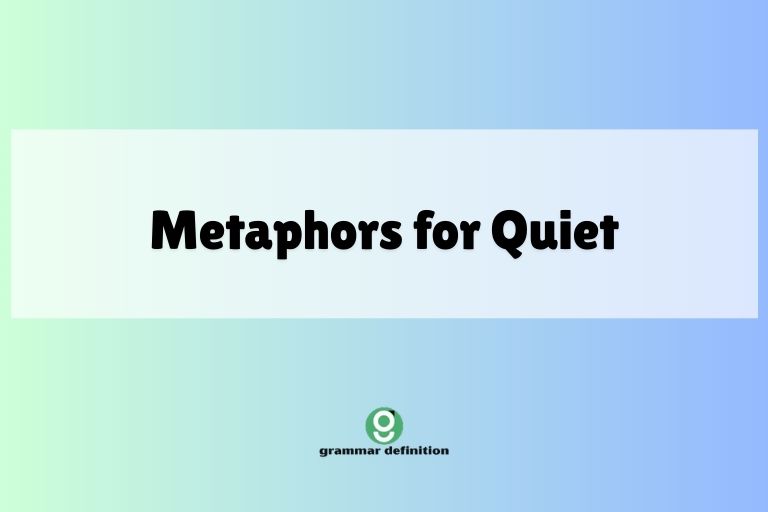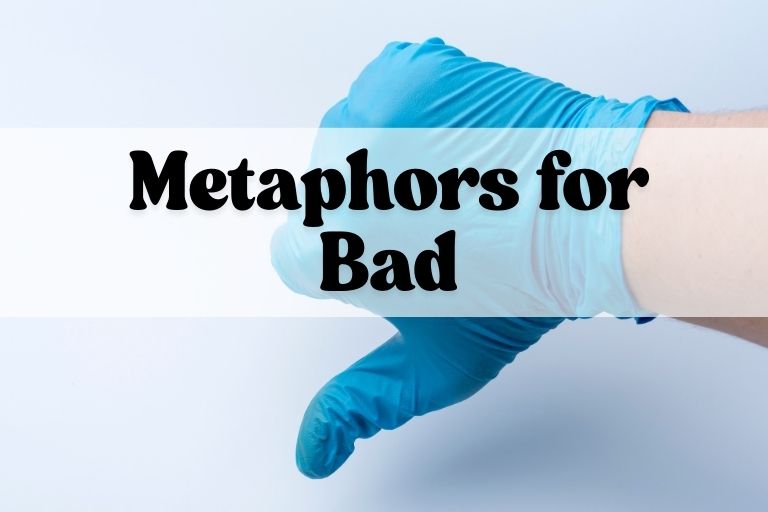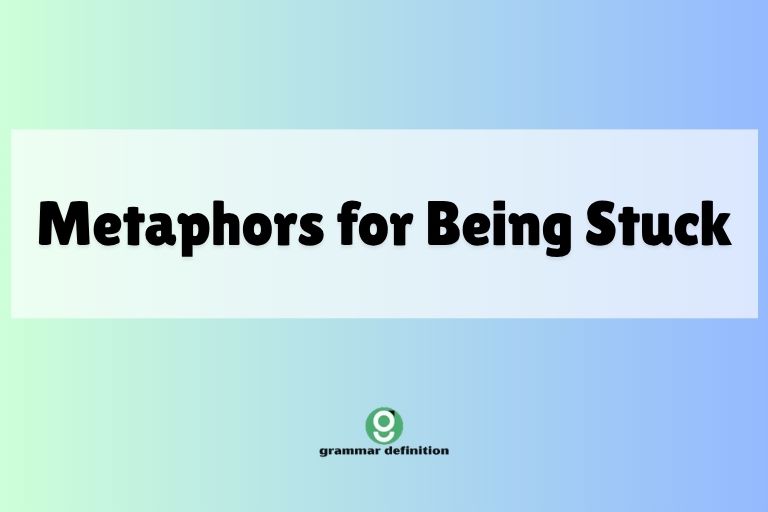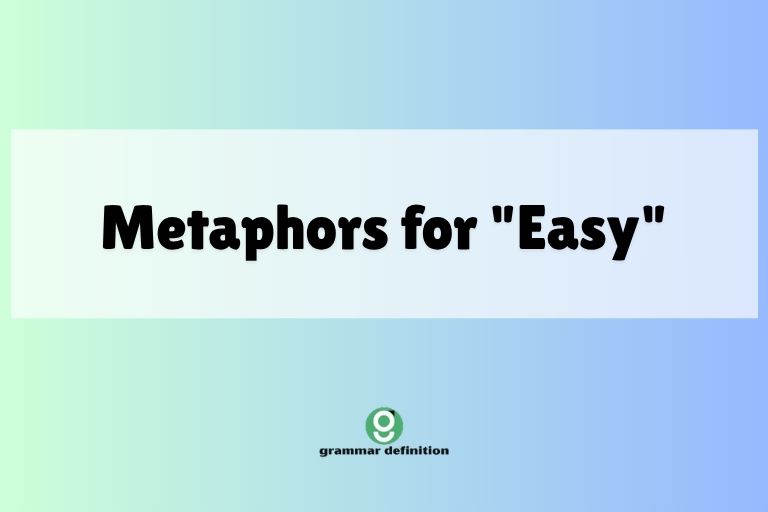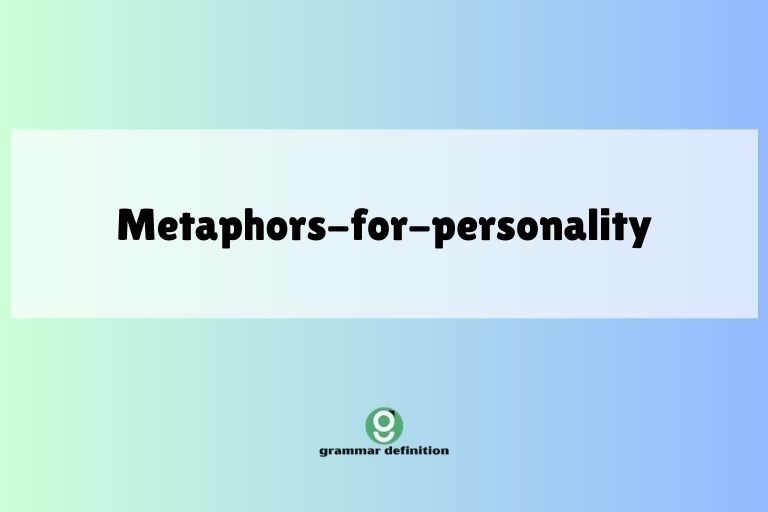Metaphors for Nervousness: A Comprehensive Guide
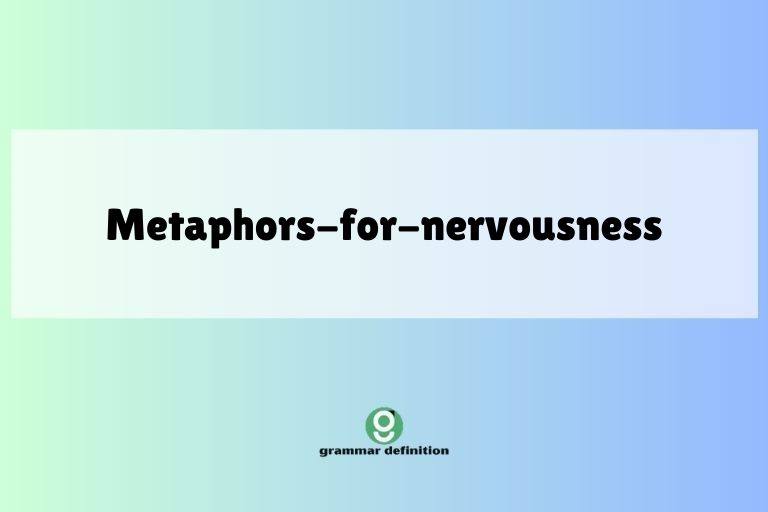
Understanding how to express nervousness using metaphors is a crucial skill for enhancing your English communication. Metaphors allow you to convey complex emotions and experiences in a vivid and relatable way, making your language more engaging and impactful.
This article will explore various metaphors for nervousness, providing definitions, examples, usage rules, and practice exercises to help you master this aspect of English grammar. Whether you’re an ESL learner, a student, or simply someone looking to improve their vocabulary, this guide offers valuable insights into the art of metaphorical expression.
Table of Contents
- Introduction
- Definition of Metaphor and Its Role in Describing Nervousness
- Structural Breakdown of Metaphors
- Types of Metaphors for Nervousness
- Examples of Metaphors for Nervousness
- Usage Rules for Metaphors
- Common Mistakes When Using Metaphors for Nervousness
- Practice Exercises
- Advanced Topics: Extended Metaphors and Symbolism
- Frequently Asked Questions
- Conclusion
Definition of Metaphor and Its Role in Describing Nervousness
A metaphor is a figure of speech that directly compares two unrelated things, asserting that one is the other. Unlike similes, which use “like” or “as” to make a comparison, metaphors create a more implicit and imaginative connection. The power of metaphor lies in its ability to transfer qualities from one concept to another, providing new insights and perspectives.
In the context of nervousness, metaphors are invaluable for expressing the often-intangible feelings of anxiety, apprehension, and unease. They allow us to translate internal sensations into concrete, relatable terms.
For example, instead of simply saying “I was nervous,” you might say “My stomach was a knot,” which vividly conveys the physical discomfort associated with nervousness. This makes your communication more engaging and allows your audience to better understand your emotional state.
Structural Breakdown of Metaphors
A typical metaphor consists of two main elements: the tenor and the vehicle. The tenor is the subject being described (in our case, nervousness), and the vehicle is the object or concept used to describe the tenor. The vehicle lends its qualities to the tenor, creating the metaphorical meaning.
For instance, in the metaphor “His voice was a shaky leaf,” the tenor is “his voice,” and the vehicle is “a shaky leaf.” The qualities of a shaky leaf (fragility, instability) are transferred to the concept of his voice, suggesting that his voice was trembling or unsteady due to nervousness. The effectiveness of a metaphor depends on the aptness of the comparison and the degree to which it resonates with the audience.
Types of Metaphors for Nervousness
Metaphors for nervousness can be categorized into several types, each drawing on different aspects of experience to express the feeling. Understanding these categories can help you choose the most appropriate and effective metaphor for a given situation.
Physical Sensations
These metaphors describe nervousness by comparing it to physical discomfort or unusual bodily sensations. Nervousness often manifests physically, so these metaphors are particularly relatable.
Common examples include butterflies in the stomach, a racing heart, or sweaty palms. These metaphors highlight the tangible effects of nervousness on the body.
Animalistic Comparisons
This category uses animal behavior or characteristics to represent nervousness. Animals are often associated with instinctual reactions and vulnerability, making them apt vehicles for expressing feelings of anxiety.
Examples include feeling like a trapped animal, a deer in headlights, or a caged bird. These metaphors emphasize the sense of being overwhelmed or helpless.
Natural Phenomena
Metaphors in this category draw parallels between nervousness and natural events, such as storms, earthquakes, or tsunamis. These comparisons evoke the feeling of being overwhelmed by powerful and uncontrollable forces.
Examples include a storm brewing inside, feeling like an earthquake was shaking you, or being swept away by a tidal wave of anxiety. These metaphors illustrate the intensity and disruptive nature of nervousness.
Mechanical Malfunctions
These metaphors compare nervousness to the breakdown or malfunctioning of machinery. This category highlights the sense of being out of control or not functioning properly.
Examples include feeling like gears were grinding, wires were crossed, or an engine was sputtering. These metaphors convey the feeling of internal disruption and the inability to perform as expected.
Examples of Metaphors for Nervousness
To further illustrate the different types of metaphors for nervousness, let’s examine specific examples within each category. These examples will provide a clearer understanding of how these metaphors are used in practice and how they can enhance your communication.
Physical Sensations Examples
This table provides a comprehensive list of metaphors that use physical sensations to describe nervousness. Each example is designed to vividly convey the bodily experience of anxiety.
| Metaphor | Explanation | Example Sentence |
|---|---|---|
| Butterflies in my stomach | A fluttering sensation in the stomach | Before the presentation, I had butterflies in my stomach. |
| My heart was racing | An accelerated heartbeat due to anxiety | When I saw the exam, my heart was racing. |
| Sweaty palms | Increased perspiration on the hands | He had sweaty palms as he waited for the results. |
| My throat was dry | A sensation of dryness in the throat | My throat was dry, and I could barely speak. |
| A knot in my stomach | A tight, uncomfortable feeling in the abdomen | I had a knot in my stomach before the interview. |
| My knees were weak | A feeling of instability in the legs | My knees were weak when I stepped onto the stage. |
| Cold sweat | A chilling perspiration | He broke out in a cold sweat as the deadline approached. |
| My hands were trembling | Involuntary shaking of the hands | My hands were trembling as I opened the letter. |
| My voice was shaking | An unsteady voice due to nerves | My voice was shaking when I made the announcement. |
| I felt lightheaded | A sensation of dizziness | I felt lightheaded from all the stress. |
| My skin was crawling | A tingling, uneasy sensation on the skin | My skin was crawling as I waited for the verdict. |
| My stomach was churning | A feeling of nausea and unease | My stomach was churning before the big game. |
| My head was pounding | A throbbing headache | My head was pounding with anxiety. |
| I felt a lump in my throat | A sensation of tightness and difficulty swallowing | I felt a lump in my throat when I said goodbye. |
| My muscles were tense | A feeling of tightness and stiffness in the muscles | My muscles were tense from the constant worry. |
| I felt like I couldn’t breathe | A sensation of shortness of breath | I felt like I couldn’t breathe when I heard the news. |
| My face was flushed | Redness of the face due to nervousness | My face was flushed when he complimented me. |
| I felt a pit in my stomach | A sinking feeling of dread | I felt a pit in my stomach when I realized my mistake. |
| My breath was shallow | Short, quick breaths | Her breath was shallow as she waited for her turn. |
| I felt wired | Feeling jittery and on edge | I felt wired after drinking too much coffee before the interview. |
| My vision blurred | Temporary loss of clear sight | My vision blurred for a moment as the pressure mounted. |
| I felt tingling in my fingers | A prickling sensation in the extremities | I felt tingling in my fingers when I realized what was happening. |
| My teeth were chattering | Involuntary clicking of the teeth | My teeth were chattering from the cold and the fear. |
| I felt a shiver run down my spine | A sudden trembling sensation | I felt a shiver run down my spine as the suspense built. |
| My stomach flipped | A sudden feeling of unease or queasiness | My stomach flipped when the car swerved suddenly. |
| I felt like my blood was ice | A chilling feeling of fear | I felt like my blood was ice as the horror movie played on. |
Animalistic Comparisons Examples
The following table provides examples of metaphors that use animal comparisons to convey feelings of nervousness. These metaphors capture the instinctual and often vulnerable aspects of anxiety.
| Metaphor | Explanation | Example Sentence |
|---|---|---|
| Like a deer in headlights | Paralyzed with fear and confusion | He stood there like a deer in headlights, unable to react. |
| Like a caged bird | Feeling trapped and restless | She felt like a caged bird, longing for freedom from her anxiety. |
| Like a cornered rat | Feeling desperate and defensive | He fought back like a cornered rat when his reputation was threatened. |
| Like a frightened rabbit | Timid and easily startled | She was like a frightened rabbit, jumping at every shadow. |
| Like a fish out of water | Feeling uncomfortable and out of place | He felt like a fish out of water at the formal event. |
| Like a lamb to the slaughter | Unsuspecting and vulnerable | They led him like a lamb to the slaughter, unaware of the danger. |
| Like a nervous cat | Restless and easily agitated | She paced like a nervous cat, waiting for the phone to ring. |
| Like a trapped animal | Feeling confined and desperate to escape | He felt like a trapped animal in his stressful job. |
| Like a hummingbird | Fidgety and unable to stay still | She fluttered around like a hummingbird, too nervous to sit down. |
| Like a scared mouse | Timid and easily frightened | He scurried away like a scared mouse when he heard the loud noise. |
| Like a hawk circling its prey | Anticipating something with a mix of excitement and dread | He watched her like a hawk circling its prey, knowing she was about to make a mistake. |
| Like a snake ready to strike | Tense and ready to react defensively | He was coiled like a snake ready to strike, prepared for any challenge. |
| Like a butterfly emerging from its cocoon | A mix of anticipation and fear of the unknown | She felt like a butterfly emerging from its cocoon as she started her new life. |
| Like a peacock spreading its feathers | Trying to appear confident despite inner nervousness | He strutted like a peacock spreading its feathers, hoping to impress the crowd. |
| Like a chameleon changing colors | Adapting to a situation while feeling uneasy | She shifted like a chameleon changing colors, trying to fit in. |
| Like a meerkat on alert | Hyper-vigilant and watchful | He stood like a meerkat on alert, scanning the surroundings. |
| Like a sheep in wolf’s clothing | Insecurely trying to appear confident | He presented himself like a sheep in wolf’s clothing, hoping no one would notice his fear. |
| Like a turtle retreating into its shell | Withdrawing from a situation due to fear | She retreated like a turtle into its shell when confronted with criticism. |
| Like a lion pacing in its cage | Restless and agitated | He paced like a lion pacing in its cage, waiting for the verdict. |
| Like a skittish horse | Easily spooked or startled | She was as skittish as a horse before her first public speaking event. |
| Like a pack of wolves circling | Feeling surrounded and threatened | He felt like a pack of wolves were circling him as the accusations mounted. |
| Like a lone wolf howling | Expressing deep seated anxiety and loneliness | He felt like a lone wolf howling in the night, filled with anxiety and loneliness. |
| Like an owl wide-eyed in the day | Disoriented and uncomfortable | She felt like an owl wide-eyed in the day when asked to perform outside her comfort zone. |
| Like a bear awakened from hibernation | Groggy and unprepared | He felt like a bear awakened from hibernation when he realized he was late for the meeting. |
| Like a swarm of bees | Feeling a buzz of anxiety and unease | She felt like a swarm of bees was buzzing in her head before the exam. |
Natural Phenomena Examples
This table provides metaphors that use natural phenomena to describe the overwhelming and disruptive nature of nervousness.
| Metaphor | Explanation | Example Sentence |
|---|---|---|
| A storm brewing inside | A build-up of anxiety and tension | There was a storm brewing inside him as he prepared for the confrontation. |
| Like an earthquake shaking me | Feeling intensely shaken and unstable | I felt like an earthquake shaking me when I heard the shocking news. |
| Swept away by a tidal wave of anxiety | Overwhelmed by intense anxiety | She was swept away by a tidal wave of anxiety before the performance. |
| Like a volcano about to erupt | Suppressed emotions on the verge of explosion | He felt like a volcano about to erupt with anger and frustration. |
| A whirlwind of emotions | A chaotic mix of feelings | She was caught in a whirlwind of emotions after the breakup. |
| Like a hurricane raging | Intense and destructive anxiety | His mind was like a hurricane raging with worry and doubt. |
| A flood of fear | An overwhelming surge of fear | A flood of fear washed over her when she saw the dark alley. |
| Like a landslide of worries | A sudden and overwhelming influx of concerns | He was buried like a landslide of worries under the weight of his responsibilities. |
| A fog of uncertainty | A state of confusion and doubt | He was lost in a fog of uncertainty about his future. |
| Like a drought of confidence | A lack of self-assurance and belief | She suffered like a drought of confidence before the competition. |
| Like thunder rolling in the distance | An impending sense of doom | He felt the anxiety like thunder rolling in the distance, knowing something bad was about to happen. |
| Like quicksand sucking me down | Feeling trapped and overwhelmed | The stress felt like quicksand sucking me down, and I couldn’t escape. |
| Like a snowstorm blinding me | Feeling disoriented and unable to see clearly | The pressure felt like a snowstorm blinding me, making it hard to focus. |
| Like lava flowing through my veins | A burning, intense feeling of anxiety | The anxiety felt like lava flowing through my veins, making me restless. |
| Like a tremor before a major quake | A small sign of much bigger anxiety | He felt the first tremor of anxiety before the major event. |
| Like a pressure cooker building steam | Anxiety building to a breaking point | She felt like a pressure cooker building steam as the deadline neared. |
| Like a forest fire spreading | Anxiety rapidly growing out of control | His worries spread like a forest fire as he considered all the possible outcomes. |
| Like a dark cloud looming | A sense of impending negativity | A dark cloud loomed over her as she thought about the upcoming surgery. |
| Like a desert stretching endlessly | Feeling isolated and hopeless | He felt like a desert stretching endlessly before him, with no relief in sight. |
| Like a frozen wasteland | Feeling emotionally numb and desolate | She felt like a frozen wasteland after the devastating loss. |
| Like a dense fog rolling in | A feeling of confusion and disorientation | A dense fog rolled in, clouding his thoughts and making it hard to concentrate. |
| Like a river overflowing its banks | An overwhelming surge of emotions | Her emotions overflowed their banks as she talked about her childhood. |
| Like a mountain crumbling | A feeling of collapse under pressure | He felt like a mountain crumbling under the weight of his responsibilities. |
| Like a black hole sucking everything in | A feeling of being consumed by negativity | His depression felt like a black hole sucking everything in, leaving nothing behind. |
| Like a shooting star, brief and intense | A short burst of anxiety | The panic was like a shooting star, brief and intense before fading away. |
Mechanical Malfunctions Examples
This table provides examples of metaphors that use mechanical malfunctions to describe the feeling of being out of control or not functioning properly due to nervousness.
| Metaphor | Explanation | Example Sentence |
|---|---|---|
| Gears grinding | Difficulty thinking or functioning smoothly | My mind felt like gears grinding as I tried to solve the problem. |
| Wires crossed | Confusion and miscommunication | I felt like wires were crossed in my brain, and I couldn’t think straight. |
| Engine sputtering | Inability to function at full capacity | My energy felt like an engine sputtering, and I couldn’t focus. |
| A short circuit in my brain | A temporary mental shutdown | I felt like there was a short circuit in my brain when I saw the unexpected guest. |
| Like a broken record | Repeating the same anxious thoughts | My mind was like a broken record, repeating the same worries over and over. |
| A glitch in the system | A minor malfunction causing disruption | I felt like there was a glitch in the system when I forgot my lines on stage. |
| Like a machine on the verge of breaking down | Feeling close to emotional collapse | He felt like a machine on the verge of breaking down from the constant stress. |
| The brakes were failing | Losing control of emotions or actions | I felt like the brakes were failing as my anger escalated. |
| Like a rusty cog in a machine | Feeling slow and inefficient | I felt like a rusty cog in a machine, unable to keep up with the pace. |
| The battery was running low | Feeling drained and depleted | My energy felt like the battery was running low, and I needed to recharge. |
| Like a computer crashing | Experiencing a complete mental shutdown | The stress felt like a computer crashing, and I couldn’t process anything. |
| Like a dial spinning out of control | Thoughts accelerating uncontrollably | My thoughts went like a dial spinning out of control when I received the news. |
| Like a fuse about to blow | Reaching a breaking point | He felt like a fuse about to blow under the immense pressure. |
| Like a robot malfunctioning | Feeling disconnected and out of sync | She moved like a robot malfunctioning, unable to express any emotion. |
| Like a program running in the background | Constant, underlying anxiety | The anxiety felt like a program running in the background, always present. |
| Like a traffic jam in my brain | Overwhelmed with thoughts | My brain felt like a traffic jam, making it hard to focus on anything. |
| Like a broken thermostat | Inability to regulate emotions | She felt like a broken thermostat, swinging between extremes of emotion. |
| Like a skipping record | Repetitive, intrusive thoughts | My thoughts kept skipping like a record stuck on repeat, driving me crazy. |
| Like a faulty connection | Feeling disconnected from others | He felt like there was a faulty connection between him and his family. |
| Like a runaway train | Thoughts and feelings spiraling out of control | Her anxiety was like a runaway train, picking up speed with each passing moment. |
| Like a machine overheating | Reaching a point of burnout | He felt like a machine overheating as he worked long hours without rest. |
| Like a circuit overloaded | Feeling overwhelmed and unable to process | Her senses were overloaded, like a circuit overloaded with too much input. |
| Like a stripped gear | Lacking the ability to move forward | He felt like a stripped gear, unable to move forward in his career. |
| Like a jammed printer | Unable to express oneself clearly | He felt like a jammed printer, unable to communicate his thoughts effectively. |
| Like a tangled mess of wires | Feeling confused and disorganized | His thoughts were a tangled mess of wires, making it hard to make sense of anything. |
Usage Rules for Metaphors
While metaphors can enrich your language, it’s important to use them effectively. Here are some guidelines to follow:
- Clarity: Choose metaphors that are easily understood by your audience. Avoid obscure or overly complex comparisons.
- Relevance: Ensure the vehicle of your metaphor is relevant to the tenor. The qualities you are transferring should make sense in the context.
- Originality: While common metaphors can be effective, try to create original comparisons that add a fresh perspective.
- Consistency: Avoid mixing metaphors that clash or create confusing imagery.
- Moderation: Don’t overuse metaphors. Too many metaphors can make your language sound contrived or overwhelming.
Common Mistakes When Using Metaphors for Nervousness
Here are some common mistakes to avoid when using metaphors for nervousness:
| Incorrect | Correct | Explanation |
|---|---|---|
| My nervousness was a brick wall of butterflies. | I had butterflies in my stomach. | Mixing metaphors creates confusing imagery. |
| He was as nervous as a rock. | He was as nervous as a deer in headlights. | The comparison should be relevant and evocative. |
| The storm in my heart was racing. | A storm was brewing inside me, and my heart was racing. | Avoid combining unrelated metaphors in a single phrase. |
Practice Exercises
Test your understanding of metaphors for nervousness with these exercises.
Exercise 1: Identifying Metaphors
Identify the metaphor in each sentence and explain what it means.
| Question | Answer |
|---|---|
| 1. Before the interview, she felt like a caged bird. | Metaphor: Caged bird. Meaning: Feeling trapped and restless due to anxiety. |
| 2. His anxiety was a storm brewing inside him. | Metaphor: Storm brewing inside. Meaning: A build-up of tension and worry. |
| 3. Her mind felt like gears grinding as she tried to concentrate. | Metaphor: Gears grinding. Meaning: Difficulty thinking or functioning smoothly. |
| 4. He stood there like a deer in headlights, unable to speak. | Metaphor: Deer in headlights. Meaning: Paralyzed with fear and confusion. |
| 5. The pressure was like a volcano about to erupt. | Metaphor: Volcano about to erupt. Meaning: Suppressed emotions on the verge of explosion. |
| 6. My thoughts were a tangled mess of wires before the exam. | Metaphor: Tangled mess of wires. Meaning: Feeling confused and disorganized. |
| 7. She felt like she was swept away by a tidal wave of anxiety. | Metaphor: Swept away by a tidal wave. Meaning: Overwhelmed by intense anxiety. |
| 8. His stomach was a knot before going on stage. | Metaphor: Knot in the stomach. Meaning: A tight, uncomfortable feeling in the abdomen. |
| 9. He paced like a lion in a cage, waiting for the results. | Metaphor: Lion in a cage. Meaning: Restless and agitated. |
| 10. Before the race, his heart was like a drum solo. | Metaphor: Drum solo. Meaning: Heart beating rapidly and loudly. |
Exercise 2: Creating Metaphors
Create a metaphor for nervousness using the given prompts.
| Prompt | Example Answer |
|---|---|
| 1. Describe the feeling of anticipation before a big event. | I felt like I was balancing on a tightrope, one wrong step and I’d fall. |
| 2. Describe the physical sensation of sweaty palms. | My palms were like slippery fish, hard to hold onto anything. |
| 3. Describe the feeling of being overwhelmed by anxiety. | I felt like I was drowning in a sea of worries, unable to reach the shore. |
| 4. Describe the sensation of a racing heart. | My heart was like a hummingbird, fluttering wildly in my chest. |
| 5. Describe the feeling of mental confusion due to nervousness. | My mind felt like a shattered mirror, reflecting fragmented and distorted thoughts. |
| 6. Describe the feeling of being trapped by anxiety. | I was stuck in a maze of my own making, each turn leading to more anxiety. |
| 7. Describe the feeling of being exposed and vulnerable. | I felt like a snail without its shell, exposed and defenseless. |
| 8. Describe the feeling of being on edge. | I was as tight as a coiled spring, ready to snap at any moment. |
| 9. Describe the feeling of impending doom. | A dark cloud hung over me, casting a shadow on everything I tried to do. |
| 10. Describe the feeling of being overwhelmed by thoughts. | My head felt like a beehive, buzzing with a million thoughts at once. |
Advanced Topics: Extended Metaphors and Symbolism
For advanced learners, exploring extended metaphors and symbolism can add depth and nuance to your writing. An extended metaphor is a metaphor that is developed over several lines or even an entire piece of writing. It allows for a more detailed and complex exploration of the comparison.
Symbolism involves using objects or ideas to represent something else. For example, a storm might symbolize inner turmoil, or a caged bird might symbolize a lack of freedom. Incorporating symbolism into your metaphors can add layers of meaning and resonance to your expression of nervousness. For instance, instead of simply saying “I was nervous,” you could develop an extended metaphor about being lost in a dark forest, with each tree representing a specific fear or worry. This creates a more immersive and impactful experience for the reader.
Frequently Asked Questions
Here are some frequently asked questions about using metaphors for nervousness:
- What is the difference between a metaphor and a simile?
A metaphor directly compares two things, stating that one is the other. A simile uses “like” or “as” to make a comparison, indicating a similarity rather than an identity. For example, “He is a lion” (metaphor) vs. “He is like a lion” (simile).
- How can I come up with original metaphors?
Think about the specific qualities of nervousness you want to convey. Consider different areas of experience (nature, animals, machines) and brainstorm connections between these areas and the feeling of nervousness. The more you practice, the easier it will become to generate creative comparisons.
- Is it okay to use clichés?
While clichés can be effective in certain contexts, they often lack impact due to overuse. Try to avoid relying solely on clichés and strive for more original and imaginative metaphors.
- How do I know if a metaphor is effective?
An effective metaphor should be clear, relevant, and evocative. It should resonate with your audience and provide a fresh perspective on the subject. If your metaphor is confusing or doesn’t make sense, it may not be effective.
- Can I use multiple metaphors in one sentence?
While it’s possible to use multiple metaphors in one sentence, it’s generally best to avoid doing so, as it can create confusing imagery. Focus on developing a single, powerful metaphor instead.
- How can I improve my metaphorical language skills?
Read widely and pay attention to how authors use metaphors. Practice writing your own metaphors and ask for feedback from others. The more you
practice, the better you will become at using metaphorical language effectively.
Conclusion
Mastering the use of metaphors for nervousness can significantly enhance your ability to communicate complex emotions and experiences. By understanding the different types of metaphors, following usage rules, and practicing regularly, you can enrich your language and connect more effectively with your audience.
Whether you’re describing your own feelings or crafting compelling narratives, metaphors are a powerful tool for bringing your words to life. Embrace the art of metaphorical expression, and watch your communication skills soar.

